
The Flash is the name of several superheroes appearing in American comic books published by DC Comics. Created by writer Gardner Fox and artist Harry Lampert, the original Flash first appeared in Flash Comics #1. Nicknamed "the Scarlet Speedster", all incarnations of the Flash possess "superspeed", which includes the ability to run, move, and think extremely fast, use superhuman reflexes, and seemingly violate certain laws of physics.

Red Tornado is a fictional character appearing in American comic books published by DC Comics. As the second character to assume the identity of Red Tornado, he is the result of an android being merged with a sentient tornado by T.O. Morrow.

Brainiac is a supervillain appearing in American comic books published by DC Comics. The character was created by writer Otto Binder and artist Al Plastino, and debuted in Action Comics #242. He has since endured as one of Superman and the Justice League's greatest enemies. The character's name is a portmanteau of the words brain and maniac.
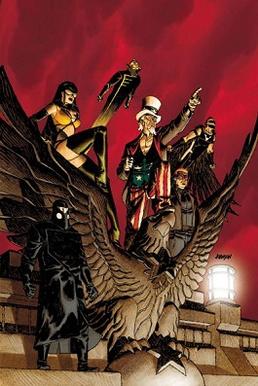
The Freedom Fighters is a superhero team appearing in American comic books published by DC Comics. The original six characters were the Black Condor, Doll Man, the Human Bomb, the Ray, the Phantom Lady, and Uncle Sam. Although the characters were created by Quality Comics, they never were gathered in a group before being acquired by DC. The team first appeared in a Justice League of America/Justice Society of America team-up, which ran in Justice League of America #107–108, written by Len Wein and drawn by Dick Dillin. Their own ongoing series premiered with Freedom Fighters #1, written by Gerry Conway and Martin Pasko, and drawn by Ric Estrada.
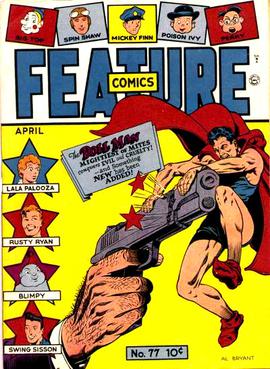
Doll Man is a superhero first appearing in American comic books from the Golden Age of Comics, originally published by Quality Comics and currently part of the DC Comics universe of characters. Doll Man was created by cartoonist Will Eisner and first appeared in a four-page story entitled "Meet the Doll Man" in Feature Comics #27. He was Quality's first super-powered character.

Ultraman is the name of several supervillains appearing in stories published by DC Comics. The characters are all evil or corrupted alternate-universe counterparts of Superman. Ultraman first appeared in Justice League of America #29.

The Flash is a superhero appearing in American comic books published by DC Comics. He is the second character known as the Flash, following Jay Garrick. The character first appeared in Showcase #4, created by writer Robert Kanigher and penciler Carmine Infantino.
Earth-Two is a setting for stories appearing in American comic books published by DC Comics. First appearing in The Flash #123 (1961), Earth-Two was created to explain differences between the original Golden Age and then-current Silver Age versions of characters such as the Flash, and how the current (Earth-One) versions could appear in stories alongside earlier versions of the same character concepts. Earth-Two includes DC Golden Age heroes, including the Justice Society of America, whose careers began at the dawn of World War II, concurrently with their first appearances in comics. Earth-Two, along with the four other surviving Earths of the DC Multiverse, were merged into one in the 1985 miniseries Crisis on Infinite Earths. However, following the events of Infinite Crisis, the Multiverse was reborn, although the subsequent Earth-Two was not the same as its pre-Crisis equivalent.

The Human Bomb is a fictional superhero published by DC Comics. He first appeared in Police Comics #1, and was created by writer and artist Paul Gustavson.
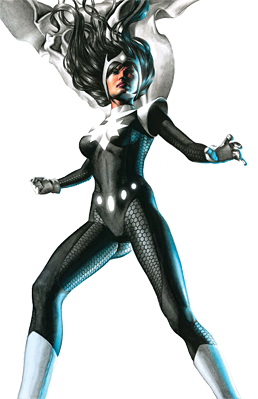
Doctor Light is a superhero appearing in comic books published by DC Comics. Kimiyo Hoshi is a distinct character from the villain of the same name. She has, however, crossed paths with the villainous Doctor Light on several occasions.
Black Condor is the superhero name used by three different fictional characters in the DC Comics universe. All three incarnations of Black Condor have been members of the Freedom Fighters and each has been featured in Freedom Fighters comic books published by DC Comics.

Uncle Sam is a superhero appearing in American comic books published by DC Comics. Based on the national personification of the United States, Uncle Sam, the character first appeared in National Comics #1 and was created by Will Eisner.

Superboy-Prime, also known as Superman-Prime or simply Prime, is a DC Comics superhero turned supervillain and an alternate version of Superman. The character first appeared in DC Comics Presents #87 and was created by Elliot S. Maggin and Curt Swan.

Neon the Unknown is a fictional superhero from the Golden Age of Comic Books created by Jerry Iger for Quality Comics. Neon first appeared in a story penciled and inked by Alex Blum in Hit Comics #1 and was featured on the cover of issue two drawn by Lou Fine. His stories ran in issues 1–17.

The Ray is a fictional character, a superhero in the DC Comics Universe. He is the second character to use the codename the Ray. Ray Terrill first appeared in The Ray #1, and was created by Jack C. Harris and Joe Quesada.
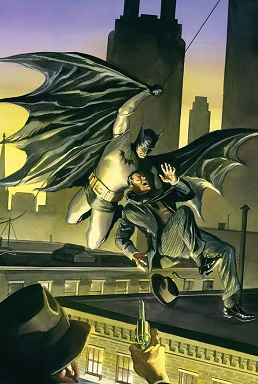
The Batman of Earth-Two is an alternate version of the superhero Batman, who appears in American comic books published by DC Comics. The character was introduced after DC Comics created Earth-Two, a parallel world that was retroactively established as the home of characters whose adventures had been published in the Golden Age of comic books. This provided justification within the fictional world of Batman stories for DC Comics publishing Batman comic books that disregarded the character's Golden Age stories, as Batman had been presented as a single ongoing incarnation of the character since his earliest stories were published.

The Monitors are a group of fictional comic book characters, who appear in books published by DC Comics.
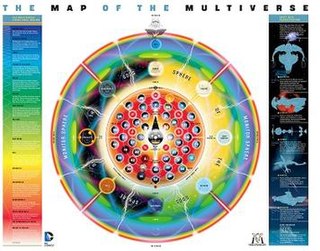
In most of the DC Comics media, the Multiverse is a "cosmic construct" composed of the many fictional universes the stories of DC media take place in. The worlds in the multiverse share a space and fate in common, and its structure has changed several times in the history of DC Comics.
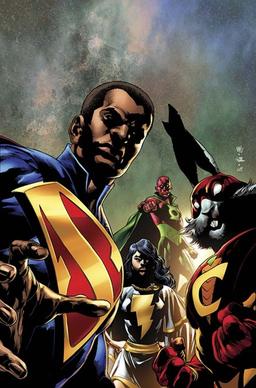
The Multiversity is a two-issue limited series combined with seven interrelated one-shots set in the DC Multiverse in The New 52, a collection of universes seen in publications by DC Comics. The one-shots in the series were written by Grant Morrison, each with a different artist. The Multiversity began in August 2014 and ran until April 2015.

Freedom Fighters: The Ray is an American animated series developed by Greg Berlanti and Marc Guggenheim. It premiered on December 8, 2017, on The CW's online streaming platform, CW Seed and is based on DC Comics character Ray Terrill / The Ray, a housing rights advocate who gains light-based powers after being exposed to a genetic light bomb. The series is part of the Arrowverse franchise and is primarily set on the dystopian Earth-X, while also partly taking place on Earth-1, a parallel universe of Arrow, The Flash, Vixen and Legends of Tomorrow.



















